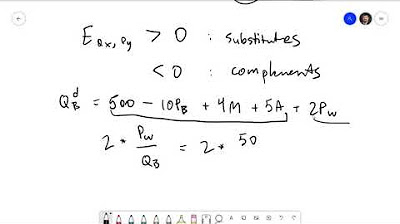How To Understand Elasticity (Economics)
TLDRIn this educational video, Craig from Market Power demystifies the economic concept of elasticity using an exercise band analogy. He demonstrates how elasticity measures the responsiveness of quantity demanded to a price change, comparing it to how different bands stretch under force. By illustrating with examples like bananas and blueberries, Craig shows that a more elastic demand leads to a greater change in quantity demanded for a given price change. This understanding is crucial for economists and policymakers, especially when considering the impact of taxes and tariffs, as elasticity dictates how consumers and suppliers will respond to such changes.
Takeaways
- 📚 Elasticity is a fundamental concept in economics that helps to understand how responsive consumers are to changes in price.
- 🤔 The term 'elasticity' should evoke the image of an elastic band or exercise band, which is a useful analogy for understanding economic concepts.
- 🏋️♂️ To determine which band is more elastic, one should consider how much each band stretches under the same force, rather than just how much they can stretch overall.
- 🍌 In the context of economics, the exercise band analogy is used to compare the demand for different products, like bananas and blueberries, in response to a price change.
- 📉 The demand for a product is considered elastic if the quantity demanded changes significantly with a price change, as demonstrated by the stretching of the 'banana' band more than the 'blueberry' band.
- 📈 The slope of the demand curve is indicative of the elasticity of demand; a steeper slope indicates less elastic demand.
- 🔗 The concept of elasticity is not only applicable to demand but also to supply, and understanding it is crucial for making informed economic decisions.
- 💼 Elasticity plays a significant role in public policy decisions, such as taxation and tariffs, where it helps predict how changes will affect consumer and producer behavior.
- 🚫 An example of perfectly inelastic demand is given by a tie strap, which does not stretch at all, analogous to a product where the quantity demanded does not change with price.
- 📊 Understanding elasticity can make one a better economist or policymaker by providing insights into how to effectively implement policies like taxes to achieve desired outcomes.
- 👀 The video encourages viewers to keep an eye out for elasticity in various economic scenarios, such as the impact of taxes on vaping.
Q & A
What is the main concept discussed in the video?
-The main concept discussed in the video is elasticity, an important concept in economics.
Why is elasticity considered fundamental in economics?
-Elasticity is fundamental in economics because it helps to describe the world around us better and plays a role in public policies like taxation and tariffs, as well as in business decisions regarding pricing.
What is the analogy used in the video to explain elasticity?
-The video uses an exercise band to explain elasticity, demonstrating how different bands stretch under the same force, which is analogous to how different goods respond to price changes.
How does the video demonstrate the concept of elasticity with the exercise bands?
-The video demonstrates elasticity by comparing how far two different exercise bands stretch under the same weight (force), with the yellow band stretching more than the blue one, indicating it is more elastic.
What does the video suggest to imagine when thinking about elasticity in economics?
-The video suggests imagining goods, like bananas (yellow band) and blueberries (blue band), and how the quantity demanded changes in response to a price drop, similar to how the exercise bands stretch under force.
How is the concept of elasticity related to demand curves in economics?
-The concept of elasticity is related to demand curves in that the slope of the demand curve represents the elasticity of demand; a steeper slope indicates less elastic demand.
What does the video illustrate with the example of perfectly inelastic demand?
-The video illustrates perfectly inelastic demand with a tie strap, which does not stretch at all under force, analogous to a situation where a price change does not affect the quantity demanded or supplied.
How does understanding elasticity help in policymaking?
-Understanding elasticity helps in policymaking by allowing policymakers to predict and plan for how changes, such as taxes, will affect behavior and the quantity demanded or supplied.
What is an example of a policy discussed in the video where elasticity plays a role?
-An example of a policy discussed in the video where elasticity plays a role is a tax on vaping, where understanding elasticity helps determine the necessary price increase to achieve the desired reduction in vaping.
How can viewers learn more about elasticity in the context of tariffs?
-Viewers can learn more about elasticity in the context of tariffs by watching another video by the same creator, which explains who actually pays tariffs and how elasticity comes into effect.
Outlines
📚 Understanding Elasticity in Economics
The video script introduces the concept of elasticity, a fundamental concept in economics, using an exercise band as a visual aid. Craig, the host of 'Market Power,' aims to help viewers intuitively grasp elasticity, which is crucial for understanding market forces and making informed decisions in policy and personal life. The script explains that elasticity refers to how sensitive a good's demand is to a change in price. It uses the analogy of stretching exercise bands to demonstrate how some goods (like bananas) have more elastic demand than others (like blueberries) under the same price change. The video also touches on the importance of elasticity in public policy decisions such as taxation and tariffs, and how understanding it can lead to better economic outcomes.
🚫 Applying Elasticity to Public Policy: The Case of Vaping
In the second paragraph, the script discusses the application of elasticity in public policy, specifically using the example of discouraging vaping through taxation. The video explains that to achieve a desired change in the quantity of vaping, it's essential to understand how much the price needs to be increased, which is governed by the concept of elasticity. The response to such a tax is entirely dependent on the elasticity of demand for vaping products. The script encourages viewers to watch another video for more on who actually pays tariffs, where elasticity plays a significant role, emphasizing the importance of elasticity in economic policy decisions.
Mindmap
Keywords
💡Elasticity
💡Intuitive Grasp
💡Exercise Band
💡Price Change
💡Quantity Demanded
💡Demand Curve
💡Slope
💡Perfectly Inelastic
💡Policymaker
💡Taxes
💡Market Power
Highlights
Elasticity is a fundamental concept in economics that can be difficult to understand.
The video aims to provide an intuitive grasp of elasticity using an exercise band.
Understanding elasticity can make one a better economist, policymaker, or parent.
Elasticity is important in public policies like taxation and tariffs.
Elasticity should make one think of an elastic band or exercise band.
The exercise band analogy is used to demonstrate how elasticity is measured.
The yellow band is more elastic than the blue band under the same force.
Economic elasticity is about how sensitive something is to a change in price.
The demand for bananas is more elastic than the demand for blueberries.
Demand curves can be used to represent the elasticity of products.
A steeper demand curve indicates less elastic demand.
Perfectly inelastic demand is represented by a vertical line on a demand curve.
Understanding elasticity helps in formulating effective policies like taxes on vaping.
Elasticity determines how people respond to taxes and price changes.
The video also discusses elasticity in the context of tariffs.
Elasticity plays a crucial role in who actually pays tariffs.
Transcripts
5.0 / 5 (0 votes)
Thanks for rating:





